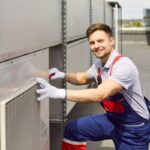Ah, winter! The time for cozy blankets, hot cocoa, and… unexpected puddles near your furnace? If you’ve stumbled upon this article, chances are you’re grappling with the latter. It’s a bummer, right? But don’t fret! Let’s unravel this wet mystery and dive deep into the world of furnace exhaust pipe leaking.
Why is My Furnace Exhaust Pipe Leaking?
It might seem like your furnace has taken up crying as a hobby, but there’s always a reason behind those sneaky drips. Here are some common culprits:
- Condensation Buildup: Modern high-efficiency furnaces produce condensation. This is normal, but if it’s not draining properly, it can lead to leaks.
- Damaged Exhaust Pipe: Wear and tear, baby! Over time, your exhaust pipe might just throw in the towel.
- Blocked Drains: Sometimes, the drain lines or trap might be blocked, causing water to backup.
The Risks of Ignoring the Leak
Ignoring the problem isn’t an option. Here’s why:
- Water Damage: No one wants a mini pool in their basement. Over time, unchecked leaks can lead to significant damage.
- Decreased Efficiency: A leaking furnace is like trying to drink with a hole in your straw – messy and not very effective.
- Safety Concerns: Water and furnaces aren’t the best mix. It can lead to serious safety hazards if not addressed.
The DIY Fix – Rolling Up Your Sleeves!
For the brave souls out there, here’s a step-by-step guide:
- Safety First: Turn off the furnace. Let’s not add “accidental shock” to the mix.
- Inspect the Exhaust Pipe: Check for visible damages. Sometimes, it’s as easy as spotting a crack or hole.
- Clean the Drain Line: Using a mix of water and vinegar, flush the drain line. Check if it’s blocked.
- Seal Minor Cracks: For small cracks, waterproof sealants can be your best bud. But remember, this is a temporary fix!
However, if you’re unsure, it’s always best to call in the pros!
Expert Tips to Keep Those Leaks at Bay
You know the saying, “An ounce of prevention is worth a pound of cure”? Here’s how you can prevent future leaks:
- Regular Maintenance: A regular check can spot issues before they escalate.
- Clean the Drain Line: At least once a year, give that drain line some love.
- Upgrade Your Exhaust Pipe: If your exhaust pipe is older than your favorite pair of jeans, maybe it’s time for a change.
The Hidden Benefits of Addressing a Furnace Exhaust Pipe Leaking:
1. Boosted Efficiency:
When you tackle the issue of a leak in the furnace exhaust pipe, your furnace will likely operate more efficiently. Leaks can cause your furnace to work harder than necessary, leading to increased energy consumption. Fixing these leaks can potentially save you money on your energy bills.
2. Longer Equipment Life:
Addressing leaks promptly can extend the life of your furnace. Like any equipment, when a furnace doesn’t have to compensate for a malfunction (like a leak), it operates under less stress, prolonging its lifespan.
3. Improved Indoor Air Quality:
A leak might introduce contaminants into your indoor environment. By sealing off these leaks, you’re not only preventing moisture but also ensuring that the exhaust and possible contaminants are appropriately vented outside. This can contribute to a healthier indoor environment for you and your loved ones.
4. Safety Assurance:
A well-maintained furnace is a safe furnace. By regularly checking and addressing issues like leaks, you reduce the risk of significant malfunctions or safety hazards in the future.
5. Peace of Mind:
Knowing that you’ve tackled and resolved a potential problem brings peace of mind. You won’t have to constantly worry about potential water damage or decreased furnace efficiency.
6. Increased Property Value:
If you’re considering selling your home in the future, a well-maintained heating system can be a selling point. Buyers often appreciate homes where potential problems have been addressed, leading to smoother transactions and possibly even a higher sale price.
7. Environmental Responsibility:
A furnace that operates efficiently has a smaller carbon footprint. By addressing leaks and ensuring your furnace is in top shape, you’re doing your part to reduce energy waste and contribute to a healthier environment.
FAQs:
- Q: Can I fix the leak on my own? A: Sure thing! But if it’s a significant issue or you’re unsure, better safe than sorry. Call in an expert.
- Q: How often should I inspect my furnace? A: At least once a year. But if you hear odd noises or see unusual things, don’t wait!
- Q: Is a little water by the furnace normal? A: A small amount of condensation is normal for high-efficiency furnaces. But persistent puddles? That’s a red flag!
Conclusion:
While no one wishes for a furnace exhaust pipe leak, addressing it and understanding its implications can lead to several tangible benefits. It’s all about turning lemons into lemonade!. A furnace exhaust pipe leaking might give you a mini heart attack, but with the right knowledge and tools, you can tackle it head-on. And hey, if all else fails, there’s no shame in calling the experts. After all, as the old saying goes, “Better to be safe than soggy!”



